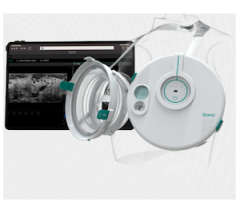
Functional diffuse optimal tomography of the brain
June 22, 2010 – By combining two relatively inexpensive technologies based on sound and light waves, researchers hope to lower the rate at which women undergo breast biopsies for suspicious lesions. Results of the study on ultrasound-guided optical tomography are published in the online edition and the August print issue of Radiology.
“The goal of our study was to investigate the potential of diffuse optical tomography in the near infrared spectrum with ultrasound localization as a means of differentiating early-stage cancers from benign lesions of the breast,” said lead researcher Quing Zhu, Ph.D., professor of bioengineering at the University of Connecticut.
When mammography and ultrasound cannot determine whether a suspicious breast lesion is malignant or benign, physicians typically recommend a needle biopsy to extract samples of the suspicious tissue for laboratory testing. In current clinical practice, 70 to 80 percent of biopsies performed reveal benign lesions, which creates unnecessary cost and anxiety for women.
Diffuse optical tomography is an emerging noninvasive imaging technique that measures light absorption within tissue to quantify blood content (hemoglobin level) and blood oxygen levels. Because cancerous lesions have many more blood vessels than normal tissue, hemoglobin levels can help distinguish malignant from benign lesions.
In Zhu’s study, 178 consecutive women underwent ultrasound-guided diffuse optical tomography (DOT) on a previously identified solid lesion, followed by a biopsy. The study, which included women between the ages of 21 and 89 years, was conducted between 2004 and 2008 at the University of Connecticut Health Center and Hartford Hospital, both in Hartford, Conn.
Performing ultrasound-guided DOT involves the use of a handheld probe consisting of a commercial ultrasound transducer located in the middle and an optical source and detector fibers around the periphery. Once ultrasound locates the lesion, DOT is performed by shining infrared light into the area and measuring light absorption at two optical wavelengths.
Researchers computed total hemoglobin levels from the light absorption measured at two wavelengths and correlated the measurements with biopsy results. Laboratory examination of tissue samples revealed two in-situ carcinomas, 35 carcinomas that measured less than 2 centimeters, 24 carcinomas greater than 2 centimeters and 114 benign lesions.
“Both maximum and average total hemoglobin levels were significantly higher in the malignant groups than in the benign group,” Zhu said.
The sensitivity and specificity of the technique (92 percent and 93 percent, respectively) were greatest when evaluating cancers less than 2 centimeters in size.
“Based on our results, we believe that ultrasound-guided diffuse optical tomography holds promise as an adjunct to diagnostic mammography and ultrasound for distinguishing early-stage invasive breast cancers from benign lesions,” Zhu said. “We expect this technology will be used to help radiologists evaluate small to intermediate size lesions that are harder to diagnose with conventional imaging technologies.”
Ultrasound and near infrared procedures cost significantly less than magnetic resonance imaging (MRI), another technique used to evaluate suspicious breast lesions that cannot be diagnosed using mammography.
The next step in Zhu’s research, which is supported by grants totaling $1.4 million from the National Institutes of Health with additional $600,000 support from the Donaghue Medical Research Foundation, is to design multi-institution clinical trials for ultrasound-guided DOT.


 January 14, 2026
January 14, 2026 








